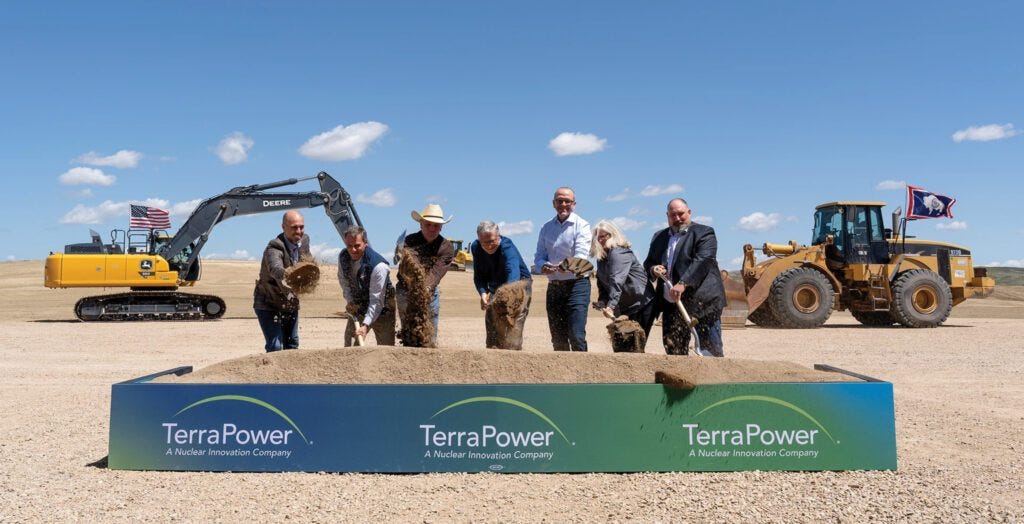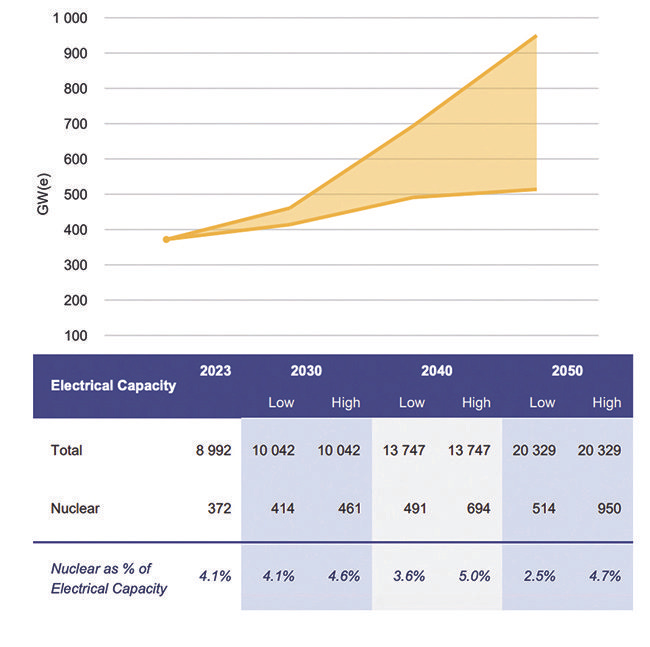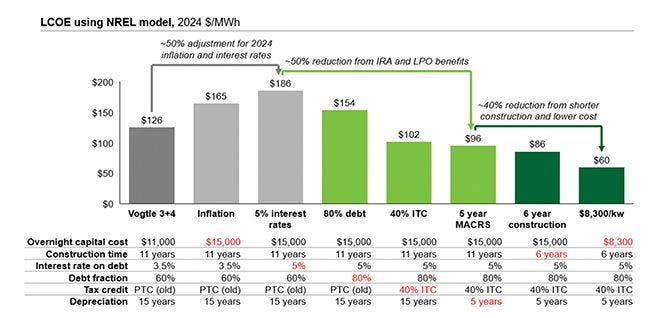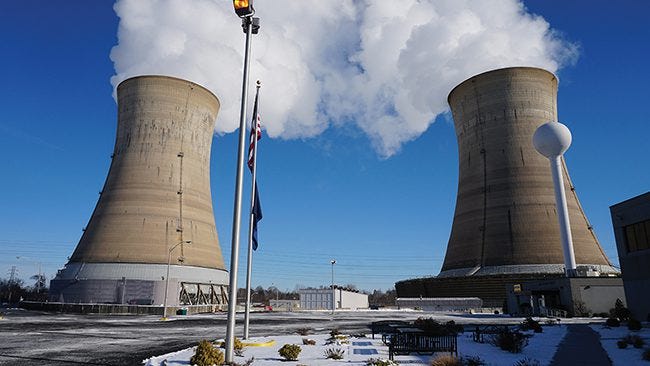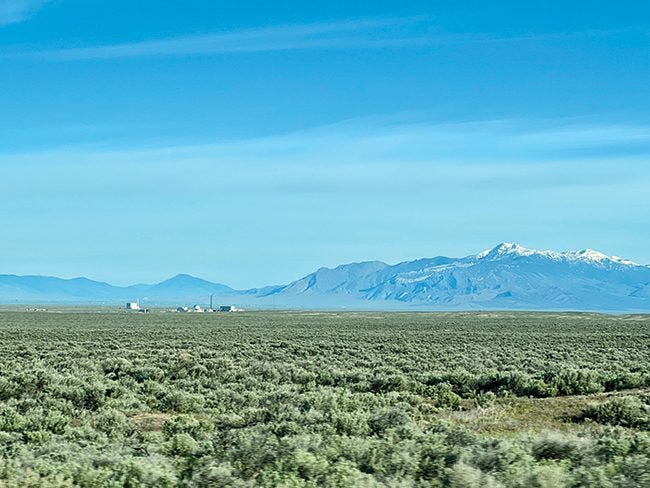LLAW’s All Things Nuclear #813, Wednesday, (11/20/2024)
NUCLEAR INSANITY: THE LAST DAYS OF HUMAN DEPRAVITY? ~ LLAW
TerraPower celebrated the start of construction on the Natrium reactor demonstration project during a groundbreaking ceremony in Wyoming on June 10, 2024. The beginning of construction activities marked the first advanced nuclear reactor project under construction in the Western Hemisphere. Courtesy: TerraPower
LLAW’s NUCLEAR NEWS & THE IMPACT ON TOMORROW
There was no new news today because all the top articles — except two or three about the ill-conceived rebound in nuclear energy after “all these years”, courtesy of a standout story from “Power” magazine that’s by far the best and most realistic review of the ridiculous and far-out optimism of our government, the nuclear industry, and Wall Street — were about Putin’s potential use of nuclear warfare, which dominated yesterday as well. So I’m just going to repeat what I had to say about that Putin nuclear war issue yesterday . . .
“The doctrine said any attack by a non-nuclear power supported by a nuclear power would be considered a joint attack, and that any attack by one member of a military bloc would be considered an attack by the entire alliance, it said.” (from the following Reuters’ article).
According to both Russia and the United States this has already happened when Ukraine recently fired long-range U.S. missiles with conventional warhead ATACMS into Russia for the 1st time at targets within Russia. So all we can do at the moment is speculate on what may or may not happen next.
But I do believe it is mandatory that the US/Ukraine violation resolution (if it is resolved) must happen before Trump takes office on January 20, 2025. But I suspect it will be delayed . . . ~llaw
The following powerful article is by far the best of the nuclear power stories (today and for many yesterdays, if not years) because it takes a long hard look at the reality of the obvious potential negative problems with nuclear power that the money markets and their ilk, including the nuclear/uranium business itself, seem to be ignoring or hiding away to reap some profits before the whole world of reality sets in . . . (My hat is off to Sonal Patel , the author of this article), ~llaw
Can Nuclear's Big Recent Wins Propel a True Global Revival?
While the past year has marked stunning triumphs for nuclear energy, experts caution that high costs, regulatory bottlenecks, and the need for market alignment remain major hurdles on the path to a true nuclear renaissance.
Nuclear energy is at an inflection point. In 2023, nuclear contributed 9.2% of the world’s total power production with an installed capacity of 371.5 GWe from 413 reactors globally. While that figure still represents a relative waning—especially if compared to nuclear’s share of 18% in the late 1990s—in September 2024, the International Atomic Energy Agency (IAEA) issued projections that point to a dramatic sectoral revival. While the agency’s high-growth scenario is ambitious—anticipating a rapid expansion that could reach up to 890 GW by 2050—even its conservative scenario is optimistic, envisioning 458 GWe by 2050 (Figure 1). The agency pointed to several prevalent drivers. Among them are climate goals that now recognize nuclear as indispensable to achieve COP28 pledges and growing international coalitions, including from 25 nations, that will work to triple nuclear capacity by 2050. Nuclear has been championed as a key solution to counter renewable variability and climate change resilience, and address energy security amid geopolitical strain.
1. The International Atomic Energy Agency (IAEA) projects that while total power capacity could increase by about 12% by 2030 and more than double by 2050, nuclear capacity could increase 2.5 times the 2023 capacity by 2050 in the high case and by about 24% by 2050 in the low case. Courtesy: IAEA
Proceeding with urgency, several countries have already acted to bolster their goals with a slew of supportive policy measures designed to manage financial and operational risks. In tandem, the nuclear industry’s long-missing market signals are growing more pronounced, riding on soaring energy demand projections from economic growth, urbanization, electrification, and lately, the scramble from tech giants to secure power for their energy-intensive data centers, and for semiconductor and chip fabrication.
Still, while the momentum is stunning for the industry that has long lagged, industry experts caution these are still early signals of progress. “Overall, we still have more than half of our generation coming from fossil fuels. To solve that problem, based on our modeling, we’re going to need at least 150 GWe of nuclear in addition to all the other energy sources—and by 2050, if that’s our net-zero goal,” said Adam Stein, director of Nuclear Energy Innovation at thinktank the Breakthrough Institute. “The question is, is it people trying to get things moving forward incrementally, or is it actually the start of the ramp up? Is it going to be a renaissance, or is it going to be just a lot of money thrown at a couple of little projects? That’s what we still have to see.”
Economic Realities, Financing, and Emerging Business Models
As Stein explained to POWER, a critical vision of the nuclear industry must be focused on achieving large-scale, sustained growth that will have a real impact on decarbonization and energy security goals. To do that, the industry must forge a pathway that can achieve “scale”—a massive gigawatt-level buildout and orders of magnitude beyond that. And to do that, it must overcome a lengthy list of formidable, persistent technical, regulatory, and institutional challenges.
2. Levelized cost of energy (LCOE) values are shown here calculated using the National Renewable Energy Laboratory (NREL) model, which includes such things as Inflation Reduction Act (IRA) and Loan Programs Office (LPO) benefits, and production tax credit (PTC) and investment tax credit (ITC) incentives. Even assuming Vogtle 3 and 4 costs inflated to 2024, “the next AP1000s could be under $100/MWh with IRA benefits and closer to ~$60/MWh with cost reductions,” suggests the U.S. Department of Energy (DOE). MACRS = modified accelerated cost recovery system. Source: Pathways to Commercial Liftoff: Advanced Nuclear (DOE, September 2024)
Perhaps the most longstanding is that nuclear plants are exceptionally capital-intensive. According to the U.S. Department of Energy (DOE), estimated overnight capital costs—without financing costs, as if a plant were to be built literally “overnight”—vary significantly, depending on region and reactor type. Vogtle 3 and 4, AP1000 reactors brought online over the past 18 months (and the first new U.S. reactors built in more than three decades), presented an overnight cost of $11,000/MWh. However, the cost of Vogtle Units 3 and 4 was adversely impacted by “construction with an incomplete design, an immature supply chain, and an untrained workforce,” the DOE notes. The AP1000 design is now complete, there is now supply chain infrastructure, and Vogtle trained more than 30,000 workers, which should all help to bring costs down on future builds (Figure 2).
The World Nuclear Association (WNA) also underscores that cost escalation has been historically stark. In France, construction costs increased from €1,170/kWe in the 1970s for Fessenheim to €8,100/kWe in 2022 for the EPR at Flamanville, owing largely to the decline in reactor build rates and heightened safety standards. At the same time, however, series builds demonstrated in successful projects in China, South Korea, and the United Arab Emirates have revealed the cost-cutting potential of standardization and steady workflows, it says. “The economics of nuclear power are much improved if a number of standard models can be ordered. The economies of series production then come into effect, and the fixed overhead costs of design and permitting involved in the supply of nuclear grade components and systems can be spread over a large number of units,” it notes.
“Possibly of equal importance is the reduction of construction and permitting risk that is associated with building numerous standardized units—which allows greater predictability and reduced timelines for the development of additional plants.” In addition, capital costs—the total cost to build a plant and bring it to operation—can be significantly reduced by learning-through-replication, scaling up unit capacities, simplifying designs, maintaining consistent licensing, and minimizing construction delays to accelerate revenue generation, it says.
Financing costs—typically comprising interest accruing during construction and for project debt and equity remuneration—of a project’s costs can also pose a steep (up to 80%) impact on total investment cost. In deregulated markets, these costs can be exacerbated by revenue uncertainty, as wholesale prices can fluctuate significantly. But here, too, new models are emerging that use frameworks like special purpose vehicles (SPV) and regulated asset bases (RAB) to share risk and provide more predictable returns. RAB models proposed for the UK’s Sizewell C project, for example, permit revenue collection during the construction phase, offsetting financing costs.
In the U.S., the DOE’s Loan Programs Office (LPO) is implementing an “equity-first” approach that reduces early high-risk exposure by requiring developers to raise private investment before accessing federal loans. The method, as a senior DOE official explained, ensures projects are “financially sound and commercially validated” before committing taxpayer dollars.
A landmark example is the $1.52 billion loan guarantee finalized in September 2024 to support Holtec International’s restart of the 800-MW Palisades nuclear plant in Michigan. The transaction marked the first loan guarantee through the Energy Infrastructure Reinvestment (EIR) program, established by the Inflation Reduction Act (IRA) Section 1706, which allows projects to leverage existing infrastructure. The framework notably also requires developers to achieve significant milestones upfront, reducing the likelihood of cost overruns or construction delays, he said.
Managing Substantial New Risks
Still, according to Stephen Greene, senior fellow at the Nuclear Innovation Alliance (NIA), while the government’s support will be crucial in jumpstarting nuclear development, over the long run—and to sustain the envisioned buildout—the nuclear industry will need to reconfigure its existing development model to mitigate financial risks that make independent development of new nuclear more challenging than other types of energy projects. At the crux of the issue is that the nuclear industry has historically proven to be notoriously slow, expensive, and risk-averse, and it requires considerable nuclear project development skillsets.
Along with large capital requirements, new nuclear projects require longer pre-construction timeframes with greater costs. And, due to the “limited commercial maturity of advanced nuclear technologies and the dearth of recent construction experience, supply chains, and construction capabilities are limited, and it is more difficult to allocate risks efficiently for a nuclear energy project today than it is for projects using more established energy technologies,” Greene explained.
“In our view, risk management is the key issue hindering the development of nuclear energy projects today. A key question is: Which parties have the motivation and the resources to take on that risk for the next few advanced nuclear energy projects?” Greene said. “Integrated electric utilities have discussed nuclear energy as an attractive option, but so far, U.S. utilities have not proposed specific projects despite recent forecasts of more rapid electricity demand growth than we’ve experienced in decades. Some users have expressed interest in purchasing power from nuclear energy projects, but most have indicated they want to be customers of such projects, not developers,” he said.
Meanwhile, “The reality is that for early-stage nuclear projects, project developers are not in a position to absorb the potential cost risk of early-stage nuclear energy,” Greene added. The entities involved—such as constructors, major equipment suppliers, and even some technology developers—don’t yet have the experience with new nuclear energy technologies to make them comfortable taking on those risks, and many don’t have the financial resources to backstop that risk. Green suggested more subsidies, like an investment tax credit, may be necessary to help offset risks and enable more private investment.
3. TerraPower celebrated the start of construction on the Natrium reactor demonstration project during a groundbreaking ceremony in Wyoming on June 10, 2024. The beginning of construction activities marked the first advanced nuclear reactor project under construction in the Western Hemisphere. Courtesy: TerraPower
To address the challenge, some advanced technology developers—traditionally tasked with maturing their technologies—have stepped up to spearhead project development. TerraPower, for example, is developing its first Natrium power plant, Kemmerer 1, in Wyoming (Figure 3), a fast reactor and energy storage hybrid project that is furnished with up to $2 billion in authorized funding under the DOE’s Advanced Reactor Demonstration Program (ARDP) and set to begin commercial operation in the early 2030s. The company, which has so far secured offtake from PacifiCorp and contracted Bechtel as its engineering, procurement, and construction (EPC) contractor, has adopted a strategy of “equity-only funding for first-of-a-kind (FOAK) projects” to avoid debt burdens and manage financial exposure, said Jeff Miller, TerraPower’s director of Business Development.
Oklo, meanwhile, is spearheading a “full value chain” approach, which involves managing the design, build, and operation of smaller reactors through power purchase agreements (PPAs)—essentially allowing Oklo to maintain greater control over costs and risk management. “Instead of starting with large, capital-intensive projects, we opted to begin with smaller reactors” based on Oklo’s liquid metal sodium fast reactor design, said Craig Bealmear, Oklo’s Chief Financial Officer. “We have found a sweet spot at the 15-MW to 50-MW reactor size, with the potential for 100 MW as we scale. This approach makes sense as our reactors are more accessible to a wide range of customers and markets, and drastically reduce upfront capital requirements, which helps accelerate deployment,” he said.
The Prospect of Leveraging Existing Coal or Nuclear Sites
As one specific potentially impactful approach to slash risks, governments around the world are facilitating the utilization of existing energy infrastructure. Site repurposing projects typically exhibit community acceptance and have regulatory background. The ability to utilize such things as existing transmission connections can help minimize costs and reduce timelines associated with new builds. Challenges exist, of course, which include environmental and physical constraints—for example, population density, seismic risks, water availability, and local policies could pose problems.
In an August 2024 report, the DOE suggested the nation’s 54 existing nuclear plant sites (which already host 94 commercial reactors) and 11 retired nuclear sites could backfit 60 GWe or 54 large-scale nuclear plants (sized like AP1000s, at 1,117-MWe), and 95 GWe from 158 smaller reactors, sized at 600 MWe. A larger array of 145 coal power sites, meanwhile, could host another 128 GWe to 174 GWe. The report identified at least 27 coal sites retired before 2020 in 16 states that could be used as new sites for new nuclear plants.
Idaho National Laboratory (INL) has separately suggested at least 18 sites are promising for near-term AP1000 deployment, and at least nine sites qualify if state policy is considered. These include the restarts already announced at Palisades and Three Mile Island Unit 1, as well as at Duane Arnold (where a feasibility study is underway) and V.C. Summer (where an AP1000 project was abandoned).
For now, however, the focus on new builds appears firmly entrenched on small modular reactor (SMR) prospects, Stein has suggested. “First, unless there are already AP1000 reactors on the site, as is the case at the Vogtle site in Georgia, no one is going to build a single large reactor. Single-unit sites simply cost more than multi-unit sites and won’t reach the low-cost estimates that have created the recent wave of enthusiasm for large LWRs [light-water reactors],” he said.
SMRs are also more feasible in liberalized markets, given they demand lower initial capital and shorter deployment timelines, aligning with market demand and corporate needs for urgent, firm power solutions. “SMRs offer the potential for lowering the absolute dollar risk bands for construction,” the DOE underscores. “As an example, a $4 billion SMR with a 50% cost overrun would result in a completed FOAK cost of $6 billion; a $10 billion reactor with the same 50% cost overrun will result in a completed FOAK cost of $15 billion.”
New Market Entrants, Industrial Demand, and Expanding Applications
As several nuclear entities have told POWER, the most forceful impetus currently driving nuclear forward is market signal. Developers are fielding substantial interest from tech giants looking to urgently feed data centers (see sidebar “Data Centers—Nuclear Energy’s New Frontier?”), but also from customers who want to secure reliable, clean, and affordable power for other industrial and commercial uses.
Data Centers—Nuclear Energy’s New Frontier?
Major deals recently unveiled by tech giants with nuclear developers over the past few months underscore considerable market signal from the energy-hungry digital sector. In September 2024, Microsoft and Constellation Energy committed $1.6 billion to restart the Unit 1 reactor of the shuttered Three Mile Island plant in Pennsylvania by 2028, now known as the Crane Clean Energy Center (Figure 4). Then, in October, Google signed a Master Plant Development Agreement to facilitate the development of a 500-MW fleet of Kairos Power molten salt nuclear reactors by 2035 to power Google’s data centers. That same week, Amazon said it would back the deployment of 5 GW of new X-energy small modular reactors projects, starting with an initial four-unit 320-MWe Xe-100 plant with regional utility Energy Northwest in central Washington. It also signed an agreement with Dominion Energy to explore a 300-MW SMR near Virginia’s North Anna Power Station.
4. Constellation in September signed a landmark 20-year agreement with Microsoft to restart Three Mile Island Unit 1 in Pennsylvania as the Crane Clean Energy Center, named after former Exelon CEO Chris Crane. The project will add 835 MW of carbon-free power to the grid, with operations expected by 2028. Courtesy: Constellation
These deals could just be the beginning. McKinsey reports that data center power demand in the U.S. could rise by 400 TWh by 2030, with a 23% compound annual growth rate. The consulting group also boldly predicts that while data centers may soon represent 30%–40% of all new demand, “hyperscalers” may be best poised to take on nuclear’s higher initial risks, given the long-term payoff in stability and low-carbon output.
Still, challenges loom large. Nuclear’s high capital costs and decade-long build timelines make rapid scale-up difficult, McKinsey warns. In addition, nuclear’s cost competitiveness with other energy options is uncertain, and while modular reactors promise efficiency gains, achieving economies of scale remains elusive. Transmission and interconnection delays pose another substantial barrier. Even co-located, islanded systems for data centers may face grid integration complexities.
In November, the Federal Energy Regulatory Commission (FERC) rejected a request to increase the amount of power that Talen Energy’s Susquehanna nuclear plant can dispatch to an Amazon data center campus. While the order has posed new uncertainties about the regulatory landscape for behind-the-meter configurations, specifically for large co-located data center loads, legal experts generally suggest they expect that FERC will use a recent co-location technical conference to initiate a generic rulemaking proceeding, an action that could provide more clarity on behind-the-meter arrangements.
For now, key nuclear players remain mostly optimistic. Constellation CEO Joe Dominguez, during an earnings call in November, underscored that the 2–1 FERC ruling “is not the final word” on co-location. “Co-location in competitive markets remains one of the best ways for the U.S. to quickly build the large data centers that are necessary to lead on AI [artificial intelligence]. As Chairman Phillips explained, our nation’s entire economy and national security is at stake if we do not lead in AI.”
Dominguez said Constellation, the nation’s largest nuclear generator, remained bullish on data center prospects. “We are seeing a wave of interest from customers who are interested in these opportunities and in our relicensing, and we are making significant progress on contracting. The intensity of our negotiations with hyperscalers and others keeps going up and up,” he said.
But he also noted data center demand was just one part of the value proposition to restart the Crane Clean Energy Center (formerly Three Mile Island)—which he hailed as a “powerful symbol of the rebirth of nuclear energy,” he said. “Second, it confirms our thesis that the most valuable energy commodity in the world today is clean and reliable electricity. And third, it underscores the growing demand for 24/7 clean energy, driven by the data economy, onshoring, and electrification. All of these macro points benefit our owners.” Given optimism for the market, Constellation is also exploring at least 1 GW of additional nuclear generation through uprates, Dominguez said.
5. Oklo Inc. announced on Nov. 7, 2024, that the DOE and the Idaho National Laboratory (INL) have completed the environmental compliance process addressing the DOE requirements for site characterization at Oklo’s first commercial advanced fission power plant site at INL. This image shows Oklo’s preferred site, with INL’s Materials and Fuels Complex, and Transient Reactor Test Facility, visible in the background. Courtesy: Oklo
Oklo’s Bealmar, for example, noted his company’s partnerships (Figure 5) had expanded rapidly from 700 MW since May 2024, when it completed a business combination with AltC Acquisition Corp., to include 1.4-GW in deals across multiple sectors—including with data center providers Equinix and Wyoming Hyperscale, and Texas-based oil and gas company Diamondback Energy. “I think the biggest question we all get is, ‘Can you move faster?’ And I think we’re all starting to get questions of ‘What can we do to help you move faster,’ which I think is a great place for the industry to be,” he said.
So far, 65 operational reactors around the world already supply heat for non-electric applications, including district heating, desalination, and industrial heat applications. Interest is now cropping up, in Finland, for example, to explore nuclear power to replace aging heat plants. Finnish nuclear startup Steady Energy’s LDR-50, a 50-MW pressurized water reactor, has garnered substantial interest for its design, which produces heat of up to 150C for district heating, industrial steam production, and desalination projects.
Cogeneration also poses a growth opportunity. Industry is already exploring value in high-temperature applications, particularly for processes requiring heat above 500C, such as hydrogen production, and the oil and gas sector. In China, nuclear-driven cogeneration projects that combine electricity and process heat for industrial complexes have reportedly yielded “significant cost savings in fuel and emissions reduction,” the IAEA notes. Haiyang nuclear plant, which began providing district heat in 2020 to replace coal-fired boilers, is now also planning a large-scale desalination plant coupled to its AP1000 reactors.
Stein told POWER that the nuclear industry’s potential to supply industrial process heat may be its biggest overlooked value proposition. “If we just talk about low-grade heat for industrial processes in the U.S., that’s the thermal output of 70 AP1000s—“a massive market that is almost entirely served by fossil fuels right now,” he underscored. The thermal energy application has broader implications for decarbonization goals beyond just electricity generation, he noted, and it should more prominently be part of nuclear’s “bigger picture,” he said.
The Risk of Regulatory Bottlenecks
Finally, and with emphasis, sources told POWER, the most insidious risk facing nuclear are outdated and stringent regulatory practices that delay its potential. Despite Congressional pressure to modernize, the Nuclear Regulatory Commission (NRC) has just begun to grapple with its new mission that requires licensing and regulation in a manner that does not “unnecessarily limit” the use of nuclear energy “or the benefits it could provide for society.” Although the NRC “seems to have finally got the message from Congress” with the ADVANCE Act, “the challenge is actual implementation,” Stein noted (see sidebar “A Compelling Case for the Rapid, High-Volume Deployment of Microreactors”).
A Compelling Case for the Rapid, High-Volume Deployment of Microreactors
The Nuclear Energy Institute (NEI), a North American trade group that works to shape nuclear policy, is fiercely pushing the Nuclear Regulatory Commission (NRC) to drastically streamline its regulatory process so that it will be supportive of an emerging brand of microreactors that could be potentially deployed in less than six months.
“Rapid high-volume deployable reactors are unlike current operating nuclear plants or other advanced small modular reactors,” wrote Marcus Nichol, executive director, NEI New Nuclear, in a recent concept paper. More akin to non-power or research reactors than commercial reactors, these 2-MWth to 50-MWth technologies are “very small in size and source term,” he explained. They enable innovative business models by allowing for extensive factory construction, appealing to customers who only want to use energy (not sell it). In addition, they reduce costs enough so that vendors can build reactors pre-emptively without specific customer orders, require minimal onsite construction, and, in some cases, can be transported fully assembled. The reactors are envisioned for remote deployment for a range of power and heat applications, including oil and gas production and development, mining and extraction, and chemical processing.
At least one company—Shepherd Power—is actively exploring the concept and has called for “sufficient clarity by the end of 2024 on a licensing pathway supporting scale microreactor deployment.” In a letter to the NRC, the subsidiary owned by oil and gas technology firm NOV said the imperative is driven by market demand. “In the Permian Basin alone, electrical demand is expected to jump from 4 GWe in 2022 to over 17 GWe in 2032, driven by electrification of oil and gas operations to reduce emissions. We led an in-depth evaluation, with participation from several major oil and gas companies, that identified a substantial number of potential upstream power and heat applications that can be served by microreactors, including water treatment, hydrogen production, and enhanced carbon capture and storage. These applications were selected because microreactors present the best technical option for achieving their decarbonization, and aggregated together, imply a very large and immediate domestic market,” it said.
NEI’s 180-day rapid-deployment concept essentially envisions five stages after site selection: mobilization and site characterization (1 month); site preparation (1 month); site assembly (2 months); delivery and emplacement (1 month); and commissioning and startup (1 month). The concept of deployment, however, is “dependent upon several milestones in the NRC process for the site license,” Nichols noted. “Currently, the NRC licensing process is complex, including many steps and features that would not be necessary for a rapid high-volume deployable reactor.”
NEI proposes a more pragmatic and efficient regulatory approach that would align with the ADVANCE Act’s Section 208, which explicitly calls for the NRC to establish a regulatory framework for microreactors. For one, it advocates for a specialized framework tailored to microreactors. NEI stresses that because these smaller reactors operate with fundamentally different source terms and simpler operational models than large-scale plants, they would need minimized safety concerns and oversight. In addition, NEI urges the NRC to drastically streamline the licensing process to aim for essentially a four-month review process: a month each for application preparation and engagement, an acceptance review, two months for the NRC’s verification review, and one for its final approval.
The NEI report stresses the need for NRC regulatory costs to remain below 1% of total project costs to keep microreactor deployment economically viable, supporting rapid, high-volume deployment models without compromising safety. By minimizing overhead, this approach ensures nuclear technologies can compete in cost-sensitive, remote, and industrial applications, it says.
In October, the NRC published a proposed rule for a Part 53 licensing pathway, an alternative to two existing licensing options (focused heavily on LWR-specific requirements), which seeks to establish risk-informed, performance-based techniques. Part 53, designed to accommodate multiple technologies, must be finalized by 2027.
“It does have a lot of things that potentially could help expedite the licensing process for advanced reactors and really just make the process more efficient without sacrificing the NRC’s independent review of safety,” said Patrick White, NIA research director. However, he said the bigger question remains: “When will this or how can this rule potentially bring benefits to applicants and have it be kind of a more predictable, efficient, and effective process?” Congress actually recognized “hesitancy to use the new rule,” so as part of the ADVANCE Act, it included a set of licensing prizes that will provide a 100% fee refund for any applicant that makes it through certain NRC licensing pathways, he noted. “The federal government is willing to essentially pay those costs for you to be that first mover,” he said.
Stein suggested many more opportunities exist for efficiency at the regulatory body, particularly for its “risk-averse regulatory paradigm,” which he said is stricter than what Congress has said is “ample margin of safety.” Its overly conservative approach “slows the process down without providing meaningful additional safety to the public,” he said.
As just one critical measure, the NRC must move away from treating each application as “entirely new” and instead “reference more easily from past decisions,” Stein said. Meanwhile, further complicating matters is that the agency is losing experienced senior staff to industry, including “change makers” in its middle ranks. That “hollowing out of the middle” is further hampering the NRC’s ability to streamline its processes as the institutional knowledge is being drained, he said.
Ultimately, for all its recent successes, alignment across the nuclear sector is emerging as the industry’s next crucial imperative. As White observed, nuclear deployment relies heavily on “lining up all the different stakeholders”—from developers, operators, and end users to state and federal officials and, crucially, a strong regulatory body, he said. For years, the industry struggled with one or more of these pieces missing, he said. “We still have work to do, but I think we’ve really got that process started.”
—Sonal Patel is a POWER senior editor (@sonalcpatel, @POWERmagazine
Nov 19, 2024
ABOUT THE FOLLOWING ACCESS TO “LLAW’S ALL THINGS NUCLEAR” RELATED MEDIA”:
(Please note that the Saturday and Sunday NUCLEAR WORLD’S NEWS — unedited —are added to Monday news posts in order to maintain continuity of nuclear news as well as for research for the overall information provided in “LLAW;s All Things Nuclear”.)
There are 7 categories, with the latest addition, (#7) being a Friday weekly roundup of IAEA (International Atomic Energy Agency) global nuclear news stories. Also included is a bonus non-nuclear category for news about the Yellowstone caldera and other volcanic and caldera activity around the world that play an important role in humanity’s lives. The feature categories provide articles and information about ‘all things nuclear’ for you to pick from, usually with up to 3 links with headlines concerning the most important media stories in each category, but sometimes fewer and occasionally even none (especially so with the Yellowstone Caldera). The Categories are listed below in their usual order:
All Things Nuclear
Nuclear Power
Nuclear Power Emergencies
Nuclear War
Nuclear War Threats
Yellowstone Caldera (Note: There are no Yellowstone Caldera bonus stories available in this evening’s Post.)
IAEA Weekly News (Friday’s only)
Whenever there is an underlined link to a Category media news story, if you press or click on the link provided, you no longer have to cut and paste to your web browser, since this Post’s link will take you directly to the article in your browser.
A current Digest of major nuclear media headlines with automated links is listed below by nuclear Category (in the above listed order). If a Category heading does not appear in the daily news Digest, it means there was no news reported from this Category today. Generally, the three best articles in each Category from around the nuclear world(s) are Posted. Occasionally, if a Post is important enough, it may be listed in multiple Categories.
TODAY’S NUCLEAR WORLD’S NEWS, Wednesday, (11/20/2024)
All Things Nuclear
NEWS
The U.S. confirms Ukraine fired U.S.-made long-range ATACMS into Russia - WUSF
WUSF
All Things Considered · 1A · Here & Now · Fresh Air · On Point · Schedule ... Both the news of possible Ukrainian strikes and Russia's updated nuclear ...
Putin's new nuclear doctrine: It's my arsenal and I'll strike if I want to - Breaking Defense
Breaking Defense
In all, the new doctrine says that Russia will use nuclear weapons whenever the president decides to do so. It also contains a laundry list of things ...
The U.S. confirms Ukraine fired long-range ATACMS into Russia for the 1st time
WCMU Public Radio
All Things Considered · Destination Out · Fresh ... nuclear strike. ... Both the news of possible Ukrainian strikes and Russia's updated nuclear doctrine ...
Nuclear Power
NEWS
Renewed U.S. Interest in Nuclear Energy: An Update - AAF
The American Action Forum
In the reaction process, the core of an atom is split apart to release a large amount of energy in the form of heat and radiation. Nuclear energy's ...
Nuclear Engineering and Technology | Vol 56, Issue 12, Pages 4947-5452 (December 2024) - ScienceDirect.com
Russia revises nuclear strike threshold against NATO members, Ukraine - POLITICO.eu
POLITICO.eu
Russian President Vladimir Putin on Tuesday signed a revised national nuclear doctrine that expands the conditions under which Moscow may use its ...
Can Nuclear's Big Recent Wins Propel a True Global Revival? - POWER Magazine
POWER Magazine
In-depth: While the past year has marked stunning triumphs for nuclear energy, experts caution that high costs, regulatory bottlenecks, ...
Nuclear Power Emergencies
NEWS
Global panic as Putin raises spectre of nuclear war — How other countries are reacting
CNBC TV18
... nuclear power as a direct threat, potentially justifying a nuclear response. ... This booklet aims to prepare citizens for various emergencies, ...
Palo Verde nuclear plant testing 70 sirens in West Valley - KTAR News
KTAR News
It's only a test of the Palo Verde Nuclear Generating Station emergency warning system. The system's 70 sirens will blare twice for about three ...
Nuclear War
NEWS
Newspaper headlines: 'Putin's nuke threat' and 'Farmageddon!' - BBC
BBC
The Times says Vladimir Putin "raises nuclear stakes" after he "lowered the threshold for a nuclear strike on the West".
LIVE: US State Department Says Washington Not Changing its Nuclear Stance After Russian Shift - YouTube
Putin takes his nuclear threats to a new level but Ukraine's allies say they aren't rattled
NBC News
If the Kremlin was hoping to instill fear among its Western foes by lowering the bar for using nuclear weapons, then it may have been disappointed ...
Will Putin Use Nuclear Weapons? What Russia's Doctrine Change Means - Bloomberg
Bloomberg
A distinctive feature of Russia's military tactics has been that it doesn't rule out using nuclear weapons in a conventional war.
Nuclear War Threats
NEWS
Newspaper headlines: 'Putin's nuke threat' and 'Farmageddon!' - BBC
BBC
Wednesday's headlines are led by growing fears over Russia's nuclear threat and the farmers' protests.
Putin takes his nuclear threats to a new level but Ukraine's allies say they aren't rattled
NBC News
Russian President Vladimir Putin's broadened nuclear doctrine appeared to be a thinly veiled threat to the United States and its allies over their ...
Putin issues warning to United States with new nuclear doctrine | Reuters
Reuters
... nuclear attack by an enemy or a conventional attack that threatened the existence of the state. The U.S. National Security Council said it had not ...





